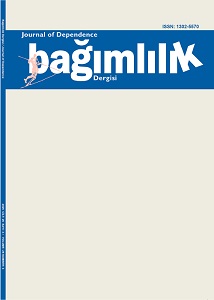Bir üniversite hastanesine alkol dışı madde kullanımı ön tanısıyla başvuran kişilerin madde tarama test sonuçlarının analizi
Anahtar Kelimeler:
Diyarbakır- Esrar- Madde TestiÖz
Giriş: İdrarda toksikolojik analiz, madde kullanımının tespitini, bağımlılığı tedavisi ve tedaviye uyumu hızlıca değerlendiren en objektif yöntemlerden biridir. Toksikolojik analizin öncelikli amacı kanunlara uygun olarak çeşitli durumlarda, yasadışı yada yasaklanmış ilaç yada maddelerin kullanımının saptanmasıdır. Bu çalışmada Dicle Üniversitesi hastanesine alkol dışı madde kullanımı ön tanısıyla başvuran kişilerin toksikolojik analiz sonuçlarının değerlendirilmesi amaçlanmıştır.
Yöntem: Çalışmamıza 2014 yılı Ocak-Aralık ayları arasında Dicle Üniversitesi Psikiyatri polikiliniğine kendi isteği veya ailesinin talebiyle başvuran ve idrarında madde metaboliti istenen 167 kişi dahil edilmiştir. Bu kişilerin dosyaları deneyimli araştırmacılar tarafından geriye dönük olarak taranarak değerlendirilmiştir.
Bulgular: Çalışma örnekleminin %88’i (n=147) erkek, %12’si (n=20) ise kadındı. Katılımcıların %44,9’unun (n=75) idrarında madde metaboliti tespit edilirken %55,1’inin (n=92) idrarında maddeye rastlanılmadı. Kişilerin kullandıkları maddeler sıklık sırasına göre esrar %88 (n=66), Methylene Dioxymetamphetamine (MDMA) %18,6 (n=14), metamfetamin %16 (n=12), opioid %5,3 (n=4), barbitürat %4 (n=3) ve fensiklidin %2,7 (n=2) olarak tespit edildi. Kadınların ise ikisinin marijuana ve birinin MDMA-metamfetamin kullandığı tespit edildi. Çoklu madde kullanımı %37,3 (n=28) iken tek madde kullanımının %62,7 (n=47) olduğu görüldü. Tek madde kullananların kırküçününün esrar, ikisinin metamfetamin, birinin MDMA ve birinin barbitürat aldığı tespit edildi.
Tartışma ve Sonuç: Çalışmamızda toksikolojik analiz yapılanların %55,1’inde maddeye rastlanılmadı. Madde testinde en sık tespit edilen madde esrardı. Bununla beraber esrardan sonra sıklıkla yine uyarıcı özellikte amfetamin ve metamfetamin kullanıldığı bulunmuş, ve ayrıca fensiklidin, barbitürat, opioid ve türevleri de pozitif çıkan diğer maddeler arasında yer almaktadır. Çok sayıda çevresel faktör esrar kullanım oranlardaki artışı ve yükselen bağımlılık yaygınlığını etkilemiş olabilir. Sonuç olarak madde kullanımı önemli bir halk sağlığı sorunudur. Maddeye ulaşma ve elde etme kolaylaştıkça kullanım oranlarındaki artış kaygı verici seviyelere varmıştır. Bölgemizin başta esrar olmak üzere madde kullanımı açısından ciddi risk taşıdığı görülmektedir. Bu veriler ışığında Diyarbakır’ın acil sağlık ihtiyaçlarının yanısıra madde kullanımıyla ilgili koruyucu tedbirlerin arttırılması gerekmektedir.
Referanslar
Ögel K. İnsan, Yaşam ve Bağımlılık Tartışmalar ve Gerekçeler. İstanbul: IQ Kültür Sanat Yayıncılık, 2001.
United Nations Office on Drugs and Crime, World Drug Report, 2005. United Nations Publication Sales No. E.05.XI.10 ISBN 92-1148200-3 Volume 1. https://www.unodc.org/pdf/WDR_2005/volume_1_web.pdf
United Nations Office on Drugs and Crime,World Drug Report, 2012. United Nations publication, ISBN: 978-92-1-148267-6 e-ISBN: 978-92-1055653-8 Sales No. E.12.XI.1. https://www. unodc.org/documents/data-and-analysis/ WDR2012/WDR_2012_web_small.pdf
Akvardarlar Y, Arıkan Z, Berkman K, Dilbaz N, Oral G, Uluğ B, Uzbay İT, Aknür Annette S, Bilici M, Tamar Gürol D, Mete L, Gürel ŞC, Zorlu N (editörler). Madde Bağımlılığı Tanı ve Tedavi Klavuzu El Kitabı. T.C. Sağlık Bakanlığı Sağlık Hizmetleri Genel Müdürlüğü, Ankara: Pozitif Matbaa, 2011.
Hser YI, Evans E, Teruya C, et al. Predictors of short-term treatment outcomes among California’s Proposition 36 participants. Evaluation and program planning 2007; 30: 187-96.
Göç İstatistikleri. http://www.tuik. gov.tr/VeriBilgi.do?alt_id=1067
Akgül A. Combating illegal cannabis cultivation and policies in Turkey. Uluslararası Güvenlik ve Terörizm Dergisi 2014; 5: 119-40.
Bilici R, Uğurlu GK, Tufan, E, ve ark. Bir bağımlılık merkezinde yatarak tedavi gören hastaların sosyodemografik özellikleri. Fırat Tıp Dergisi 2012; 17: 223-7.
Asan Ö, Tıkır B, Okay, İT, Göka, E. Sociodemographic and clinical features of patients with alcohol and substance use disorders in a specialized unit. Journal of Dependence 2015; 16: 1-8.
Şimşek Ş, Dönmezdil S, Kakdaş, E, Özen, Ş. Sociodemographic characteristics of patients admitted to Diyarbakir Research, Treatment and Training Centre for substance addiction in children and adolescents and types of substances used. Journal of Dependence 2014; 15: 23-27.
Bulut M, Savaş HA, Cansel, N, ve ark. Gaziantep Üniversitesi alkol ve madde kullanım bozuklukları birimine başvuran hastaların sosyodemografik özellikleri. Bağımlılık Dergisi 2006; 7: 65-70.
Kalaydjian A, Swendsen J, Chiu WT, et al. Sociodemographic predictors of transitions across stages of alcohol use, disorders, and remission in the National Comorbidity Survey Replication. Comprehensive psychiatry 2009; 50: 299-306.
Regier DA, Farmer ME, Rae DS, et al. Comorbidity of mental disorders with alcohol and other drug abuse. Results from the Epidemiologic Catchment Area (ECA) Study. Jama 1990; 264: 2511-8.
Sır A, Özkan M, Bayram Y, Kan A. Diyarbakır bölgesinde esrar ve eroin kullanıcılarının sosyo-demografik özellikleri. Türk Psikiyatri Dergisi 1998; 9: 291-5.
Güleç C, Köroğlu E (editörler). Psikiyatri Temel Kitabı. Ankara: Hekimler Yayın Birliği, 1997.
Macfadden W, Woody GE. Cannabis-related disorders. Sadock BJ, Sadock VA (editors.). Kaplan and Sadock’s Comprehensive Textbook of Psychiatry. Baltimore: Lippincott Williams & Wilkins, 2000: 990-999.
Palancı Y, Oto R. Diyarbakır Madde Bağımlılığı Risk Araştırması. 2015, Diyarbakır Büyükşehir Belediyesi Sosyal Hizmetler Daire Başkanlığı Projesi, Basımda.
İndir
Yayınlanmış
Sayı
Bölüm
Lisans
Telif Hakkı (c) 2025 Bağımlılık Dergisi

Bu çalışma Creative Commons Attribution-NonCommercial-NoDerivatives 4.0 International License ile lisanslanmıştır.
Dergimiz ve bu internet sitesinin tüm içeriği Creative Commons Atıf-GayriTicari-Türetilemez 4.0 Uluslararası (CC BY-NC-ND 4.0) lisansının şartları ile ruhsatlandırılmıştır. Bu durum, Budapeşte açık erişim girişiminin (BOAI) açık erişim tanımı ile uyumludur. Creative Commons Atıf-GayriTicari-Türetilemez Lisansı, kullanıcıların bir makaleyi kopyalamasına, değiştirmeden dağıtmasına ve nakletmesine ve makalenin ticari olmayan mahiyette kullanılmasına imkan tanımaktadır. CC BY-NC-ND 4.0 lisansı, yazarına uygun şekilde atfedildiği sürece açık erişimli bir makalenin ticari olmayan mahiyette kullanılmasına izin vermektedir.

